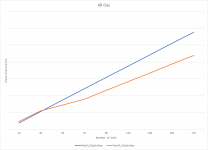Sparky2791
Senior Member
- Location
- Northeast, PA
- Occupation
- Electrical Design
I ran the calcs for a single family dwelling unit using both of these sections. The Part III calcs indicate a service load of 146A while the Part IV calcs indicate a service load of 105A. I was surprised to see that much of a difference. I triple checked to make sure both were correct. Part IV is a much easier calculation of course but seems to offer much more 'forgiveness' from a demand factor. 220.82 (B) this applies a demand factor to everything but the heat or AC whichever is larger while the Part III demand factor only applies to the General lighting/receptacle loads small appliance load and laundry load. I understand things like ranges and dryers etc. get their own demand factors applied as Part III calcs but in the situation where there is only one of each appliance no demand factor is applied.
I supposed this post is more of a statement than a question but wondering if anyone else experienced the same.
Thanks!
I supposed this post is more of a statement than a question but wondering if anyone else experienced the same.
Thanks!

